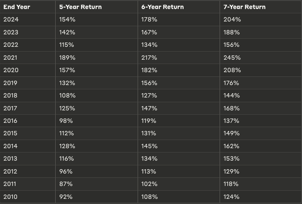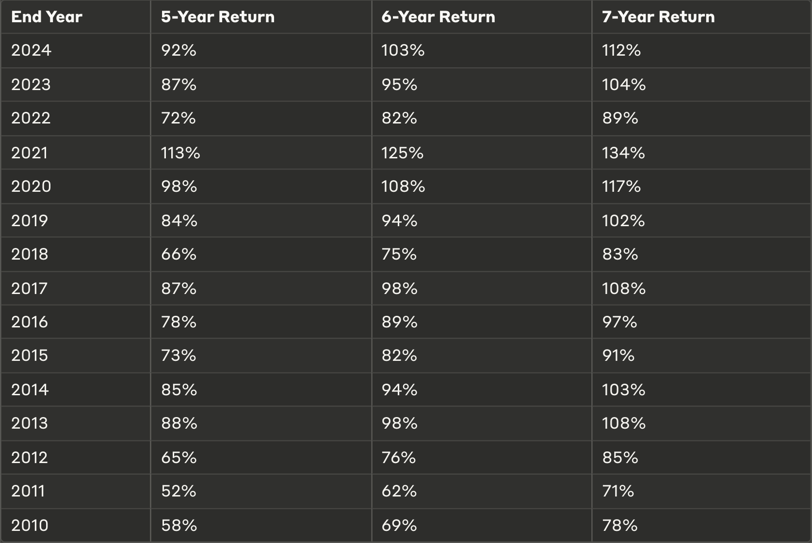Nasdaq Multi-Year Returns
Read to understand the realization I made when analyzing multi-year returns
INSIGHTS
Marc-Eric
12/24/20243 min read


The S&P 500 is generally regarded as delivering an average annual return of approximately 10%. While this figure does not guarantee a specific return, it underscores the significance of maintaining a long-term perspective and refraining from attempting to time the market. Maintaining composure and discipline in avoiding frequent trading is crucial, despite the allure of short-term gains.
Upon examining Table 1, it becomes evident that the statement holds true, as achieving a 100% return on investment (ROI) implies doubling one’s initial capital.


Table 2 - Multi-year aggregate returns of the Nasdaq-100 over 14 years


This prompted me to consider investing in a low-cost exchange-traded fund (ETF) that closely mirrors the S&P 500 as an effective strategy to achieve a desired return on investment (ROI). Regardless of the market conditions, it is generally expected that investments in such an ETF will double in value approximately every seven years.
While it is impossible to completely shield oneself from significant market events that may cause market downturns (short of sitting it out of course), it is important to acknowledge that such events can have a profound impact on long-term returns. For instance, the 2008 financial crisis had a detrimental effect on multi-year returns from 2010 to 2012. However, despite the initial setback of a low return of 58% from 2006 to 2010, the investment recovered to a 62% return after six years and reached a more in-line 85% return after seven years - not quite doubling, but almost there. After eight years (not included in the table), the investment likely surpassed 100%. It is worth noting that the 2008 year had a negative impact on the overall return, but had the investor withdrawn their funds at that time, their retirement savings would have been significantly compromised. Key learning: only the investor himself can make a downturn hurt his investments.
Therefore, time-in, or holding onto investments over the long term, emerges as a valuable risk mitigation strategy for the Fund. I am confident that my unwavering support and guidance will help you navigate the uncertainties of the market and achieve your investment goals. If you are considering investing in the Vision 2035 Fund, I encourage you to do so, as it will offer a safe haven for your investments while simultaneously providing the potential for substantial returns.
To further illustrate the effectiveness of time-in, let us examine Table 2, which presents similar returns but from the Nasdaq-100. This table demonstrates that even in the technology sector, time-in can significantly enhance the long-term performance of investments and act as protection against volatility.
Table 1 - Multi-year aggregate returns of the S&P 500 over 14 years
It does hold! And despite 2008, an investment from 2006-2010 would have brought an aggregate return of 92%. it would have gone to 102% in 2011, still doubling your money, but in 6 years! Look at the numbers that overlapped the Covid years. Eye-watering.
I believe that 2025 will also be a banner year with the US economy in great shape and an imminent Trump presidency (tax cuts and protectionism are great for the short term). Join the ride.
Past performance is not a guarantee of future performance. This blog is not investment advice.
Get a prospectus
Kindly contact us to request the prospectus. You will have the opportunity to respond and we will be happy to answer any question you may have.
retirement mindset
risk-managed Growth
© 2025. All rights reserved.
technology focus
